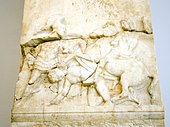Chaironeia
History
Antiquity
First settled in the Prehistoric period at the site now known as Magoula Balomenou (Μαγούλα Μπαλωμένου), its older name was Arne, and it was originally on the shore of Lake Copais (later drained). Chaeronea was subject to Orchomenus which was, beginning in 600 BC, a member of the Boeotian League. In the late 5th century BC, Chaironeia belonged to one of the 11 Boeotian districts along with Acraephnium and Copia.
Chaeronea's importance lay in its strategic position near the head of the defile which presents the last serious obstacle to an invader in central Greece, and it was the site of several historical battles. The best known is that of 338 BC, between Philip II of Macedon and a coalition of various Greek states, mainly Thebes and Athens. According to Plutarch (but disputed by modern historians), during the battle the elite unit of Theban soldiers known as the Sacred Band of Thebes was wiped out completely. In 1818, the so-called Lion of Chaeronea, a nearly 6 m (20 ft) tall funerary monument erected in honor of the Sacred Band, was rediscovered by English travellers. The fragmentary monument was reassembled and installed in 1902 by an organisation called the Order of Chaeronea atop a pedestal at the site of its discovery. The site of the Theban mass grave was excavated in 1879–80 by Panagiotis Stamatakis, and the prehistoric site of Magoula Balamenou 23 years later by the archaeologist George Soteriadis.
The ancient biographer and essayist Plutarch was born in Chaeronea, and several times refers to these and other facts about his native place in his writings. Plutarch refers to many graves of Amazons near the by the stream of Haemon, and assumes that these were casualties during the Amazon journey back home after the conclusion of the Attic War. In his Parallel Lives, he mentions the Greek prophet Peripoltas.
-
Plutarch's bust at Chaeronea
-
The Lion of Chaeronea
-
Funerary relief for Athenian footman Panchares, who probably fell at the battle of Chaeronea (338 BC)
Middle Ages
Chaeronea remained inhabited throughout Antiquity, and despite being devastated during the 551 Malian Gulf earthquake, probably remained in existence during the following centuries as well, as it is consistently attested among the cities of the Theme of Hellas. Remains of a three-aisled early Christian basilica, dedicated to Saint Paraskevi, survive.
After the Fourth Crusade and the foundation of the Crusader Duchy of Athens, a castle was built in the town, on the site of the ancient acropolis. This was part of an extensive defensive network along the Cephissus valley built by the Frankish Crusaders, and residence of its lord. In Frankish times, the town became known as Kapraina (Greek: Κάπραινα, Spanish: la Cabrena), a name first attested in 1381 and used until early modern times. The town came under Ottoman rule probably in 1460.
Transport
The settlement is served by Chaeronea railway station, with local stopping services to Athens and Leianokladi.
References
- ^ "Αποτελέσματα Απογραφής Πληθυσμού - Κατοικιών 2021, Μόνιμος Πληθυσμός κατά οικισμό" [Results of the 2021 Population - Housing Census, Permanent population by settlement] (in Greek). Hellenic Statistical Authority. 29 March 2024.
- ^ Frank H. Vizetelly, A Desk-Book of Twenty-five Thousand Words Frequently Mispronounced (New York and London: Funk & Wagnalls, 1917), p. 252.
- ^ "Πανδέκτης: Kopraina -- Chaironeia". pandektis.ekt.gr. Retrieved 2023-03-21.
- ^ "ΦΕΚ B 1292/2010, Kallikratis reform municipalities" (in Greek). Government Gazette.
- ^ "Population & housing census 2001 (incl. area and average elevation)" (PDF) (in Greek). National Statistical Service of Greece. Archived from the original (PDF) on 2015-09-21.
- ^ One or more of the preceding sentences incorporates text from a publication now in the public domain: Chisholm, Hugh, ed. (1911). "Chaeroneia". Encyclopædia Britannica. Vol. 5 (11th ed.). Cambridge University Press. pp. 788–789.
- ^ 'An Army of Lovers' – The Sacred Band of Thebes
- ^ Chisholm 1911.
- ^ Cimon – Plutarch's Lives
- ^ Koder, Johannes; Hild, Friedrich (1976). Tabula Imperii Byzantini, Band 1: Hellas und Thessalia (in German). Vienna: Verlag der Österreichischen Akademie der Wissenschaften. p. 138. ISBN 978-3-7001-0182-6.


